Effects of Different Crop Intercropping on the Growth, Root System, and Yield of Tiger Nuts
Abstract
:1. Introduction
2. Materials and Methods
2.1. Experimental Site
2.2. Experimental Materials and Experimental Design
2.3. Determination of Agronomic Traits
2.3.1. Plant Height and Tillers Number
2.3.2. Leaf Area and SPAD Value
2.4. Root Morphology Parameters
2.5. Root Length Density (RLD)
2.6. Plant Dry Weight
2.7. Yield and Land Equivalent Ratio (LER) and Aggressivity
2.8. Data Analysis
3. Result
3.1. The Plant Height of Tiger Nuts
3.2. SPAD Value of Tiger Nuts
3.3. The Tiller Numbers of Tiger Nuts
3.4. Leaf Area of Tiger Nuts
3.5. Plant Dry Weight of Tiger Nuts
3.6. Root Distribution of Tiger Nuts
3.7. The Yield of Crops and Composition Factors of Tiger Nuts
3.8. Land Equivalent Ratio (LER) and Aggressivity
3.9. Correlation between Agronomic Traits and Yield Components
4. Discussion
4.1. The Agronomic Traits of Tiger Nut
4.2. The Morphological Distribution of the Root System of Tiger Nut during the Tuber Stage
4.3. Yield of Tiger Nut and Intercropping Advantages
5. Conclusions
Author Contributions
Funding
Data Availability Statement
Conflicts of Interest
References
- Pascual, B.; Maroto, J.V.; López-Galarza, S.; Sanbautista, A.; Alagarda, J. Chufa (Cyperus esculentus L. var. sativus boeck.): An unconventional crop. studies related to applications and cultivation. Econ. Bot. 2000, 54, 439–448. [Google Scholar] [CrossRef]
- De-Vries, F.T. Chufa (Cyperus esculentus, cyperaceae): A weedy cultivar or a cultivated weed? Econ. Bot. 1991, 45, 27–37. [Google Scholar] [CrossRef]
- Rebezov, M.; Usman Khan, M.; Bouyahya, A.; Imran, M.; Tufail, T.; Loretts, O.; Shariati, M.A. Nutritional and technical aspect of tiger nut and its micro-constituents: An overview. Food Rev. Int. 2023, 39, 3262–3282. [Google Scholar] [CrossRef]
- Zhang, Y.; Sun, S. Tiger nut (Cyperus esculentus L.) oil: A review of bioactive compounds, extraction technologies, potential hazards and applications. Food Chem. X 2023, 19, 100868. [Google Scholar] [CrossRef] [PubMed]
- Liu, D.; Ji, H.; Yang, Z. Functional characterization of three novel genes encoding diacylglycerol acyltransferase (DGAT) from oil-rich tubers of Cyperus esculentus. Plant Cell Physiol. 2020, 61, 118–129. [Google Scholar] [CrossRef]
- Gasparre, N.; Rosell, C.M. Role of hydrocolloids in gluten free noodles made with tiger nut flour as non-conventional powder. Food Hydrocoll. 2019, 97, 105194. [Google Scholar] [CrossRef]
- Carvalho Barros, J.; Munekata, P.E.; de Carvalho, F.A.L.; Pateiro, M.; Barba, F.J.; Domínguez, R.; Lorenzo, J.M. Use of tiger nut (Cyperus esculentus L.) oil emulsion as animal fat replacement in beef burgers. Foods 2020, 9, 44. [Google Scholar] [CrossRef] [PubMed]
- Badejo, A.A.; Falarunu, A.J.; Duyilemi, T.I.; Fasuhanmi, O.S. Antioxidative and anti-diabetic potentials of tigernut (Cyperus esculentus) sedge beverages fortified with Vernonia amygdalina and Momordica charantia. J. Food Meas. Charact. 2020, 14, 2790–2799. [Google Scholar] [CrossRef]
- Bamishaiye, E.; Bamishaiye, O.M. Tiger nut: As a plant, its derivatives and benefits. Afr. J. Food Agric. Nutr. Dev. 2011, 11, 5157–5170. [Google Scholar] [CrossRef]
- Yang, X.; Niu, L.; Zhang, Y.; Ren, W.; Yang, C.; Yang, J.; Zhang, J. Morpho-agronomic and biochemical characterization of accessions of tiger nut (Cyperus esculentus) grown in the north temperate zone of China. Plants 2022, 11, 923. [Google Scholar] [CrossRef]
- Maduka, N.; Ire, F.S. Tigernut plant and useful application of tigernut tubers (Cyperus esculentus)—A review. Curr. J. Appl. Sci. Tech. 2018, 29, 1–23. [Google Scholar] [CrossRef]
- Arafat, S.M.; Gaafar, A.M.; Basuny, A.M.; Nassef, S.L. Chufa tubers (Cyperus esculentus L.): As a new source of food. World Appl. Sci. J. 2009, 7, 151–156. [Google Scholar]
- Wezel, A.; Casagrande, M.; Celette, F.; Vian, J.-F.; Ferrer, A.; Peigné, J. Agroecological practices for sustainable agriculture. A review. Agron. Sustain. Dev. 2014, 34, 1–20. [Google Scholar] [CrossRef]
- Willey, R.W. Resource use in intercropping systems. Agric. Water Manag. Irrig. Sugarcane Assoc. Crops 1990, 17, 215–231. [Google Scholar] [CrossRef]
- Dogliotti, S.; Van Ittersum, M.K.; Rossing, W.A.H. Influence of farm resource endowment on possibilities for sustainable development: A case study for vegetable farms in South Uruguay. J. Environ. Manag. 2006, 78, 305–315. [Google Scholar] [CrossRef] [PubMed]
- Pramanick, B.; Kumar, M.; Naik, B.M.; Singh, S.K.; Kumar, M.; Singh, S.V. Soil carbon-nutrient cycling, energetics, and carbon footprint in calcareous soils with adoption of long-term conservation tillage practices and cropping systems diversification. Sci. Total Environ. 2024, 912, 169421. [Google Scholar] [CrossRef] [PubMed]
- Raza, M.A.; Zhiqi, W.; Yasin, H.S.; Gul, H.; Qin, R.; Rehman, S.U.; Zhongming, M. Effect of crop combination on yield performance, nutrient uptake, and land use advantage of cereal/legume intercropping systems. Field Crops Res. 2023, 304, 109144. [Google Scholar] [CrossRef]
- Du, Q.; Zhou, L.; Chen, P.; Liu, X.M.; Song, C.; Yang, F.; Yong, T. Relay-intercropping soybean with maize maintains soil fertility and increases nitrogen recovery efficiency by reducing nitrogen input. Crop J. 2020, 8, 140–152. [Google Scholar] [CrossRef]
- Bargaz, A.; Isaac, M.E.; Jensen, E.S.; Carlsson, G. Intercropping of faba bean with wheat under low water availability promotes faba bean nodulation and root growth in deeper soil layers, procedia. Environ. Sci. 2015, 29, 111–112. [Google Scholar] [CrossRef]
- Betencourt, É. Interactions Entre Céréale et Légumineuse en Association et Acquisition de Phosphore du sol: Processus Rhizosphériques Sous-Jacents. Ph.D. Thesis, SupAgro, Montpellier, France, 2012. [Google Scholar]
- Hauggaard-Nielsen, H.; Jensen, E.S. Facilitative root interactions in intercrops. Plant Soil 2005, 274, 237–250. [Google Scholar] [CrossRef]
- Latati, M.; Blavet, D.; Alkama, N.; Laoufi, H.; Drevon, J.J.; Gérard, F.; Pansu, M.; Ounane, S.M. The intercropping cowpea-maize improves soil phosphorus availability and maize yields in an alkaline soil. Plant Soil 2014, 385, 181–191. [Google Scholar] [CrossRef]
- Latati, M.; Bargaz, A.; Belarbi, B.; Lazali, M.; Benlahrech, S.; Tellah, S.; Kaci, G.; Drevon, J.J.; Ounane, S.M. The intercropping common bean with maize improves the rhizobial efficiency, resource use and grain yield under low phosphorus availability. Eur. J. Agron. 2016, 72, 80–90. [Google Scholar] [CrossRef]
- Li, L.; Tilman, D.; Lambers, H.; Zhang, F.-S. Plant diversity and overyielding: Insights from belowground facilitation of intercropping in agriculture. New Phytol. 2014, 203, 63–69. [Google Scholar] [CrossRef]
- Zhao, D.; Yuan, J.; Hou, Y.; Li, T.; Liao, Y. Tempo-spatial dynamics of AMF under maize soybean intercropping. Chin. J. Eco-Agric. 2020, 28, 631–642. [Google Scholar]
- Lithourgidis, A.S.; Dordas, C.A.; Damalas, C.A.; Vlachostergios, D.N. Annual intercrops: An alternative pathway for sustainable agriculture. Aust. J. Crop Sci. 2011, 5, 396–410. [Google Scholar]
- Ezeh, O.; Gordon, M.H.; Niranjan, K. Tiger nut oil (Cyperus esculentus L.): A review of its composition and physico-chemical properties. Eur. J. Lipid Sci. Tech. 2014, 116, 783–794. [Google Scholar] [CrossRef]
- Zheng, X.; Liu, J.; Cheng, Z.; Sun, Y.; Li, L.; Wang, J. Improving Tuber Yield of Tiger Nut (Cyperus esculentus L.) through Nitrogen Fertilization in Sandy Farmland. Plants 2024, 13, 1063. [Google Scholar] [CrossRef]
- Gao, Y.; Duan, A.; Qiu, X.; Liu, Z.; Sun, J.; Zhang, J.; Wang, H. Distribution of roots and root length density in a maize/soybean strip intercropping system. Agric. Water Manag. 2010, 98, 199–212. [Google Scholar] [CrossRef]
- Adiku, S.G.K.; Ozier-Lafontaine, H.; Bajazet, T. Patterns of root growth and water uptake of a maize-cowpea mixture grown under greenhouse conditions. Plant Soil 2001, 235, 85–94. [Google Scholar] [CrossRef]
- Mead, R.; Willey, R.W. The Concept of a ‘Land Equivalent Ratio’ and Advantages in Yields from Intercropping. Exp. Agric. 1980, 16, 217–228. [Google Scholar] [CrossRef]
- Agegnehu, G.; Ghizaw, A.; Sinebo, W. Yield performance and land-use efficiency of barley and faba bean mixed cropping in Ethiopian highlands. Eur. J. Agron. 2006, 25, 202–207. [Google Scholar] [CrossRef]
- Verreynne, J.S.; Rabe, E.; Theron, K.I. The effect of combined deficit irrigation and summer trunk girdling on the internal fruit quality of ‘Marisol’ Clementines. Sci. Hortic. 2001, 91, 25–37. [Google Scholar] [CrossRef]
- Shu, H.; Wang, Y.; Zhang, S.; Liang, Y.; Lu, J.; Li, D.; Zhu, Y. Effect of light-shading on accumulation of chlorophylls and their precursors in tea shoots. J. Tea Sci. 2012, 32, 115–121. [Google Scholar]
- Steckel, L.E.; Sprague, C.L.; Hager, A.G.; Simmons, F.W.; Bollero, G.A. Effects of shading on common waterhemp (Amaranthus rudis) growth and development. Weed Sci. 2003, 51, 898–903. [Google Scholar] [CrossRef]
- Zotarelli, L.; Cardoso, E.G.; Piccinin, J.L.; Urquiaga, S.; Boddey, R.M.; Torres, E.; Alves, B.J.R. Calibration of a Minolta SPAD-502 Chlorophyll Meter for Evaluation of the Nitrogen Nutrition of Maize. Pesqui. Agropecuária Bras. 2003, 38, 1117–1122. Available online: http://www.scielo.br/pdf/pab/v38n9/18291 (accessed on 3 February 2024). [CrossRef]
- Liu, X.; Rahman, T.; Song, C.; Su, B.; Yang, F.; Yong, T.; Yang, W. Changes in light environment, morphology, growth and yield of soybean in maize-soybean intercropping systems. Field Crop Res. 2017, 200, 38–46. [Google Scholar] [CrossRef]
- de Oliveira, A.C.S.; Coelho, F.C.; Vieira, H.D.; Crevelari, J.A.; Rubim, R.F. Growth, nutrient content and SPAD value of corn in monoculture and in intercropping. Am. J. Plant Sci. 2014, 5, 49138. Available online: http://creativecommons.org/licenses/by/4.0/ (accessed on 5 February 2024).
- Bethlenfalvay, G.J.; Reyes-Solis, M.G.; Camel, S.B.; Ferrera-Cerrato, R. Nutrient transfer between the root zones of soybean and maize plants connected by a common mycorrhizal mycelium. Physiol. Plant 1991, 82, 423–432. [Google Scholar] [CrossRef]
- Statuto, D.; Picuno, P.; Abdel-Ghany, A.M. Shading methods for crop protection under greenhouse in Mediterranean areas. In Proceedings of the 47th International Symposium, Actual Tasks on Agricultural Engineering, Opatija, Croatia, 5–7 March 2019; Available online: https://iris.unibas.it/bitstream/11563/136047/2/Statuto%20et%20al.%2C%20ATAE%202019.pdf (accessed on 3 May 2024).
- Liu, W.G.; Ren, M.L. Effects of shade degrees on photosynthesis and lodging resistance degree of different shade tolerance soybean. Sci. Agric. Sin. 2016, 49, 1466–1475. [Google Scholar] [CrossRef]
- Prajapati, K.; Modi, H.A. The importance of potassium in plant growth—A review. Indian J. Plant Sci. 2012, 1, 177–186. [Google Scholar]
- Pettigrew, W.T. Potassium influences on yield and quality production for maize, wheat, soybean and cotton. Physiol. Plant. 2008, 133, 670–681. [Google Scholar] [CrossRef] [PubMed]
- Van Staden, J. Plant Roots—The Hidden Half, 3rd ed.; revised and expanded; Waisel, Y., Eshel, A., Kafkafi, U., Eds.; Marcel Dekker Inc.: New York, NY, USA, 2007; 1120p, including photographs and chemical structures, hardcover; ISBN 0-8247-0631-5. Available online: https://www.taylorandfrancis.com (accessed on 8 February 2024).
- Xia, H.Y.; Zhao, J.H.; Sun, J.H.; Bao, X.G.; Christie, P.; Zhang, F.S.; Li, L. Dynamics of root length and distribution and shoot biomass of maize as affected by intercropping with different companion crops and phosphorus application rates. Field Crops Res. 2013, 150, 52–62. [Google Scholar] [CrossRef]
- Ehrmann, J.; Ritz, K. Plant: Soil interactions in temperate multi-cropping production systems. Plant Soil 2014, 376, 1–29. [Google Scholar] [CrossRef]
- Wei, W.; Liu, T.; Shen, L.; Wang, X.; Zhang, S.; Zhang, W. Effect of maize (Zeal mays) and soybean (Glycine max) intercropping on yield and root development in xinjiang, China. Agriculture 2022, 12, 996. [Google Scholar] [CrossRef]
- Kim, B.M.; Horita, J.; Suzuki, J.I.; Tachiki, Y. Resource allocation in tragedy of the commons game in plants for belowground competition. J. Theor. Biol. 2021, 529, 110858. [Google Scholar] [CrossRef] [PubMed]
- Schenk, H.J. Root competition: Beyond resource depletion. J. Ecol. 2006, 94, 725–739. [Google Scholar] [CrossRef]
- Brown, H.B. Cotton Root Development in Certain South Louisiana Soils. 1932. Available online: https://repository.lsu.edu/cgi/viewcontent.cgi?article=1369&context=agexp (accessed on 12 February 2024).
- Te, X.; Din, A.M.U.; Cui, K.; Raza, M.A.; Ali, M.F.; Xiao, J.; Yang, W. Inter-specific root interactions and water use efficiency of maize/soybean relay strip intercropping. Field Crops Res. 2023, 291, 108793. [Google Scholar] [CrossRef]
- Ma, L.; Li, Y.; Wu, P.; Zhao, X.; Chen, X.; Gao, X. Effects of varied water regimes on root development and its relations with soil water under wheat/maize intercropping system. Plant Soil 2019, 439, 113–130. [Google Scholar] [CrossRef]
- Fan, Y.; Chen, J.; Cheng, Y.; Raza, M.A.; Wu, X.; Wang, Z.; Yang, F. Effect of shading and light recovery on the growth, leaf structure, and photosynthetic performance of soybean in a maize-soybean relay-strip intercropping system. PLoS ONE 2018, 13, e0198159. [Google Scholar] [CrossRef]
- Streit, J.; Meinen, C.; Rauber, R. Intercropping effects on root distribution of eight novel winter faba bean genotypes mixed with winter wheat. Field Crops Res. 2019, 235, 1–10. [Google Scholar] [CrossRef]
- Zhang, F.; Li, L. Using competitive and facilitative interactions in intercropping systems enhances crop productivity and nutrient-use efficiency. Plant Soil 2003, 248, 305–312. [Google Scholar] [CrossRef]
- Hauggaard-Nielsen, H.; Gooding, M.; Ambus, P.; Corre-Hellou, G.; Crozat, Y.; Dahlmann, C.; Jensen, E.S. Pea–barley intercropping for efficient symbiotic N2-fixation, soil N acquisition and use of other nutrients in European organic cropping systems. Field Crops Res. 2009, 113, 64–71. [Google Scholar] [CrossRef]
- Li, C.J.; Li, Y.Y.; Yu, C.B.; Sun, J.H.; Christie, P.; An, M.; Li, L. Crop nitrogen use and soil mineral nitrogen accumulation under different crop combinations and patterns of strip intercropping in northwest China. Plant Soil 2011, 342, 221–231. [Google Scholar] [CrossRef]
- Lauwers, M.; De Cauwer, B.; Nuyttens, D.; Cool, S.R.; Pieters, J.G. Hyperspectral classification of Cyperus esculentus clones and morphologically similar weeds. Sensors 2020, 20, 2504. [Google Scholar] [CrossRef]
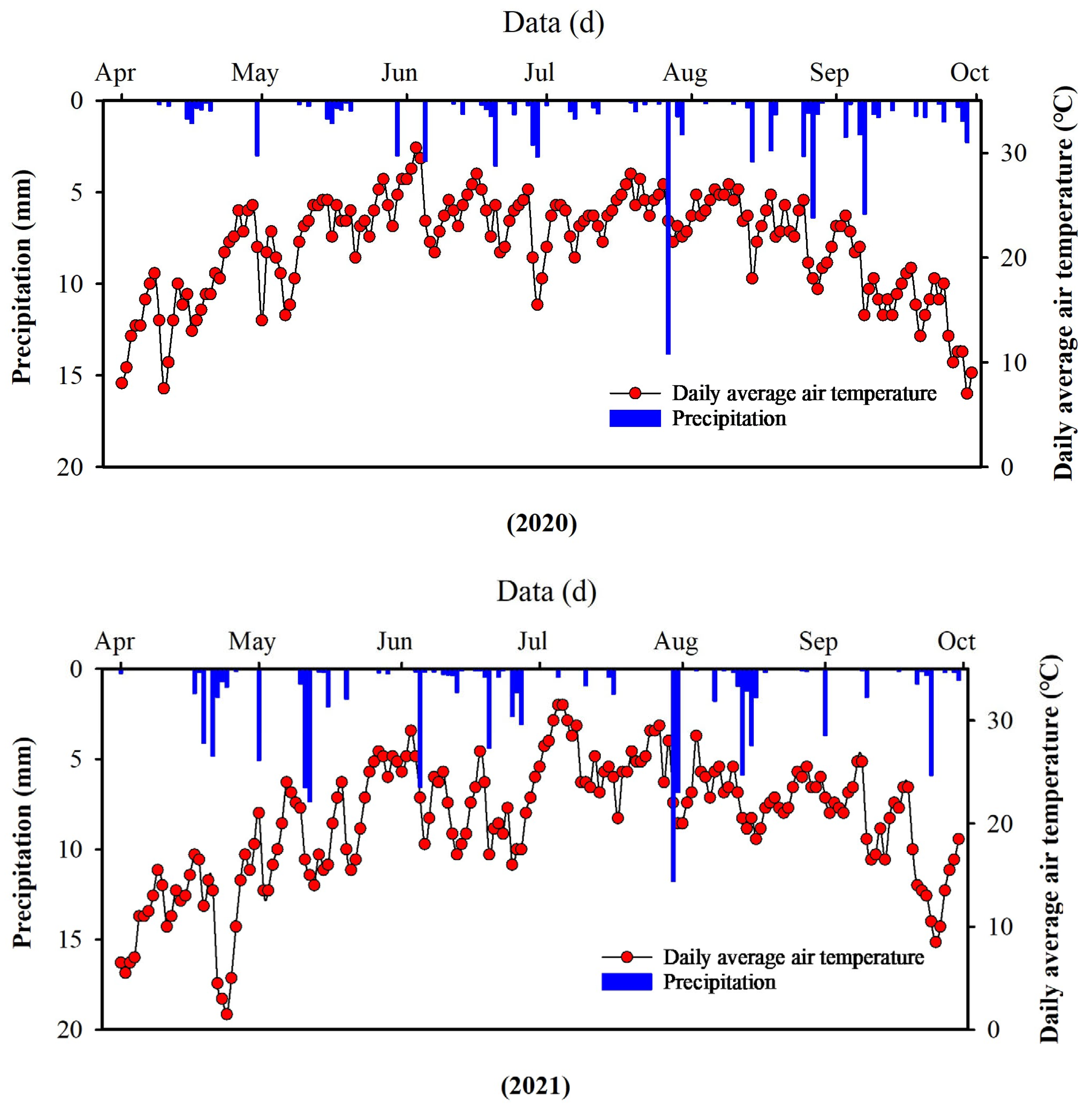
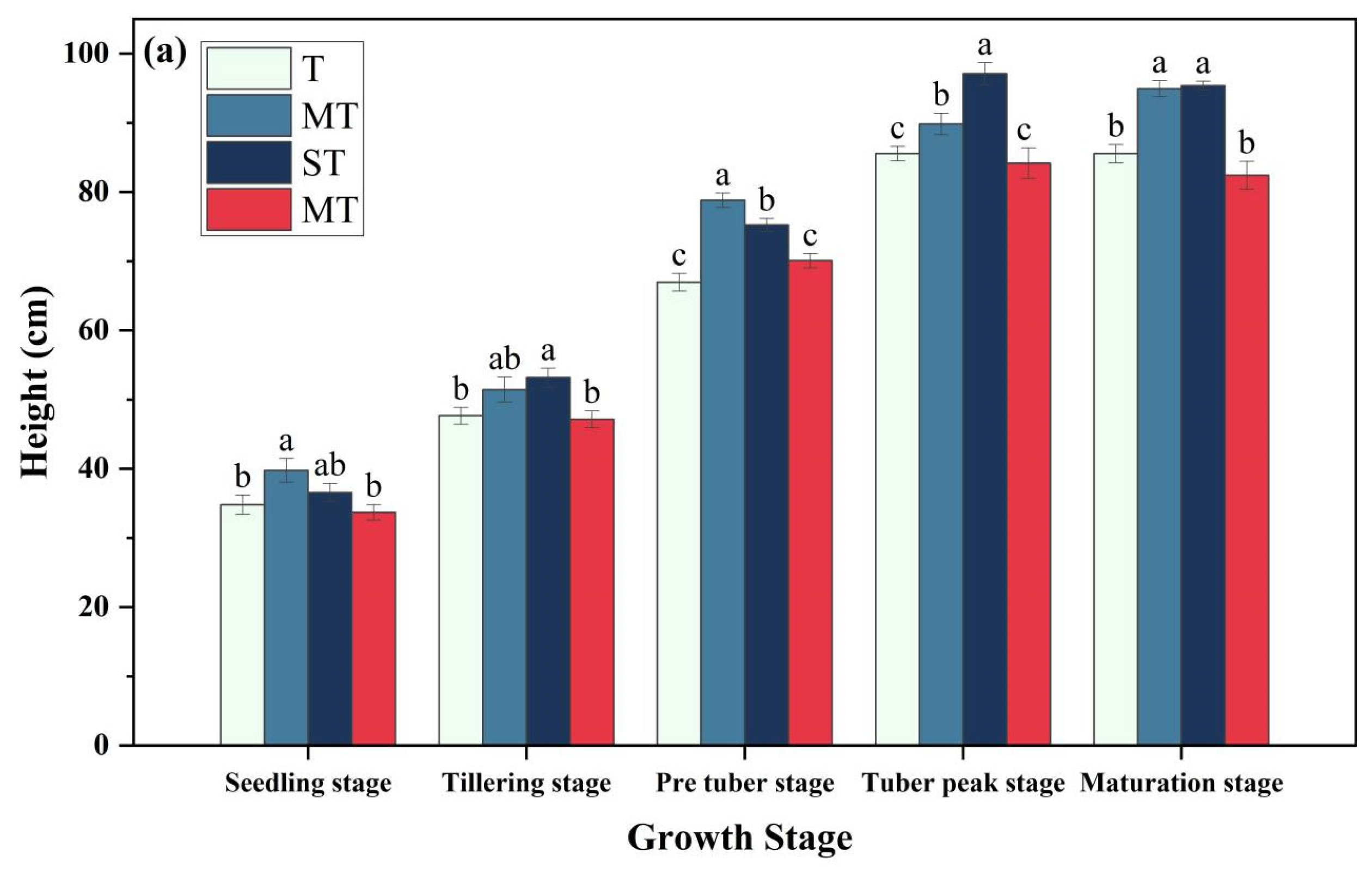

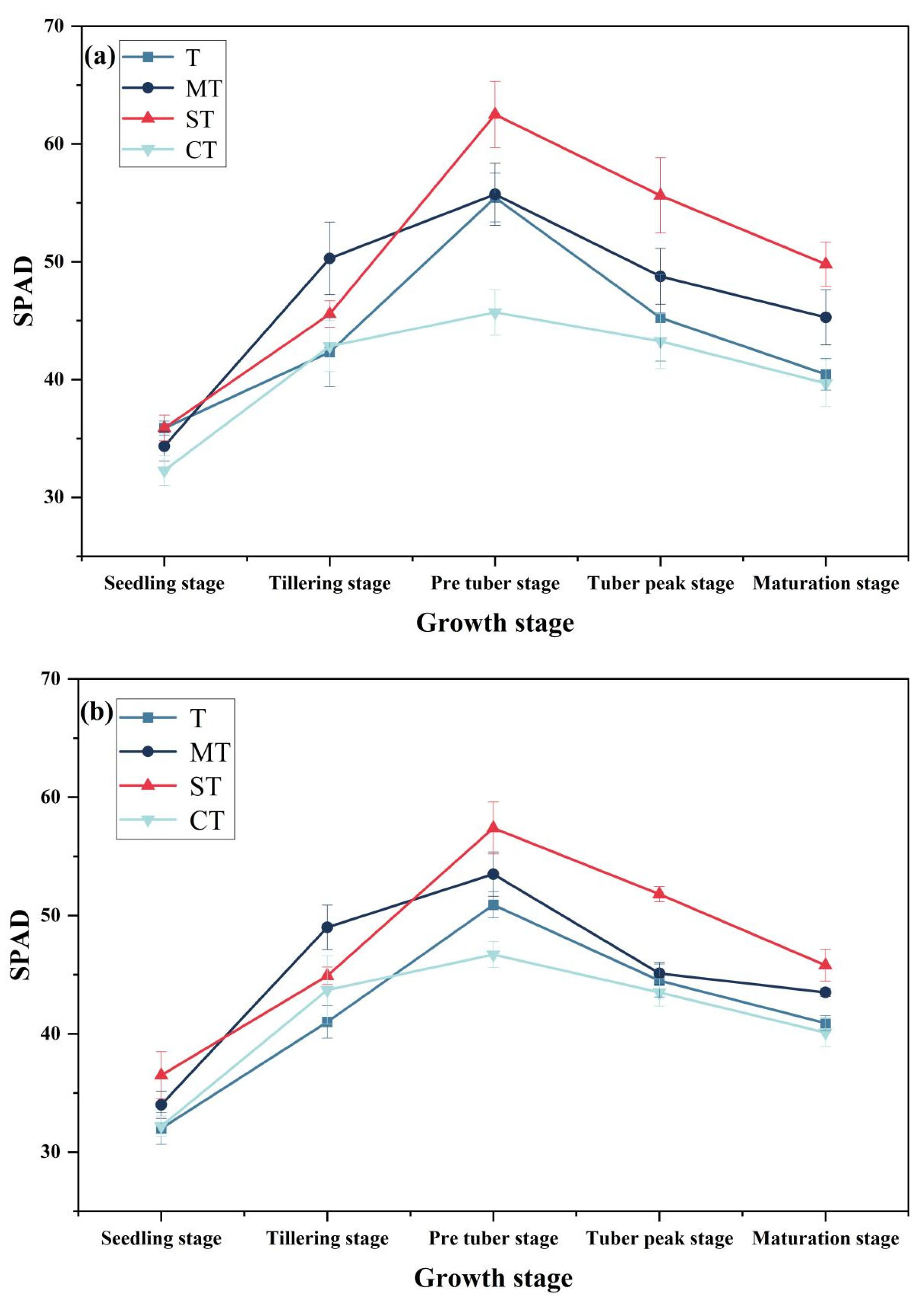


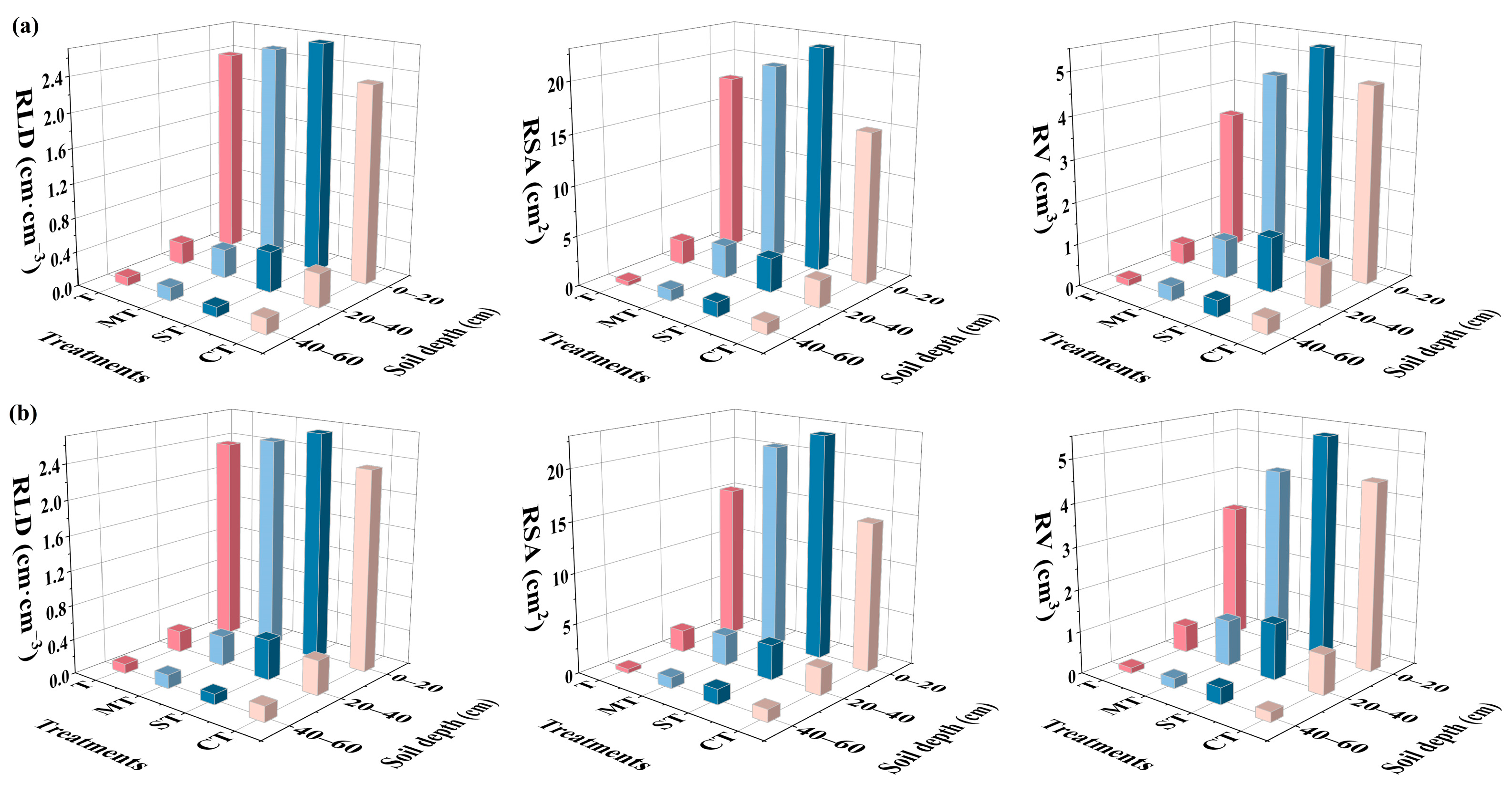
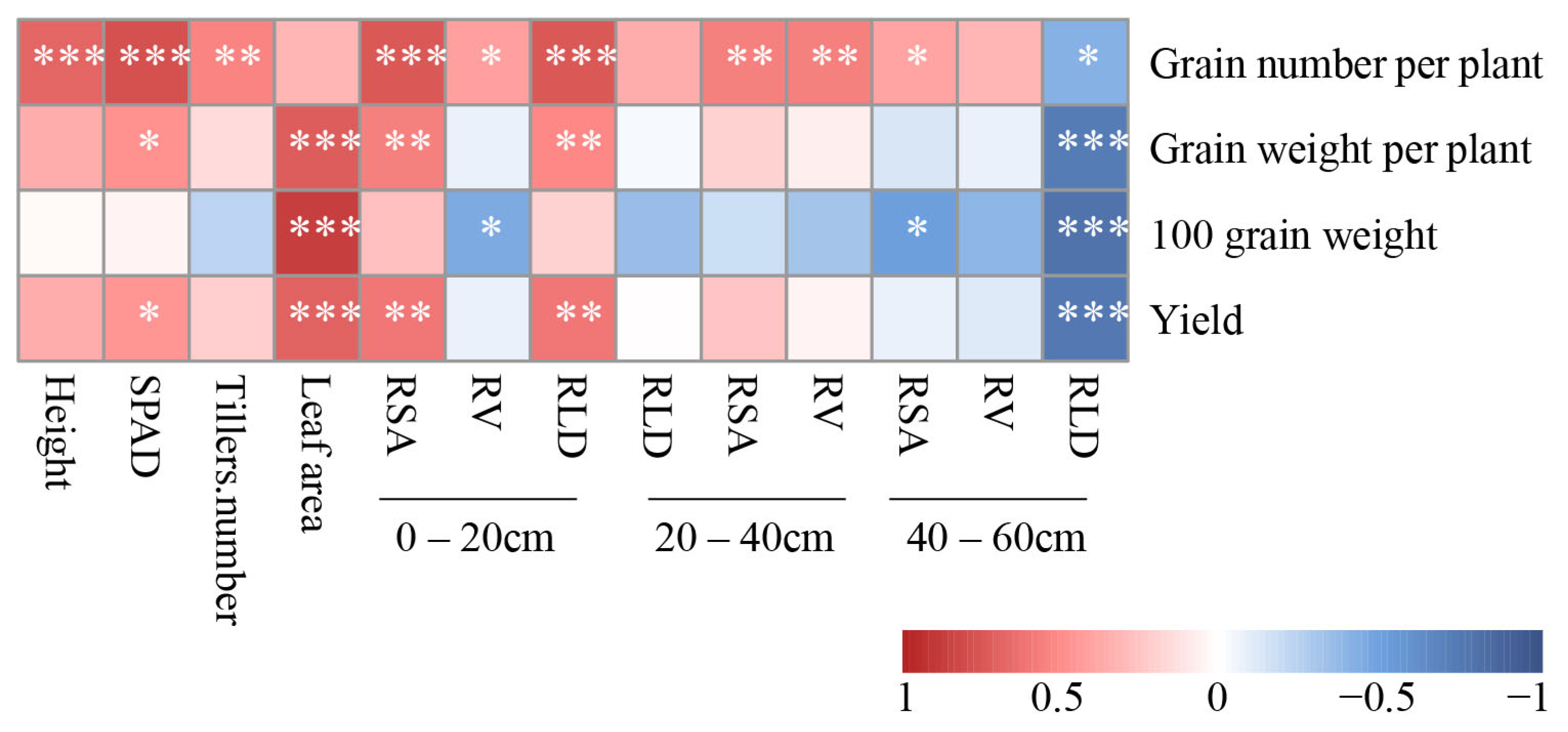
| 2020 | 2021 | |||||||
|---|---|---|---|---|---|---|---|---|
| Growth Stage | T | MT | ST | CT | T | MT | ST | CT |
| Seedling stage | 3.8 ± 0.8 b | 5.0 ± 0.7 a | 5.0 ± 0.7 a | 4.4 ± 0.6 ab | 3.6 ± 0.2 b | 5.2 ± 0.4 a | 4.8 ± 0.4 ab | 4.0 ± 0.6 ab |
| Tillering stage | 9.0 ± 1.2 c | 13.8 ± 1.3 a | 14.2 ± 0.8 a | 11.6 ± 0.8 b | 7.8 ± 0.4 c | 13.0 ± 0.7 a | 12.8 ± 0.3 a | 9.4 ± 0.5 b |
| Pre-tuber stage | 20.2 ± 1.5 c | 25.0 ± 1.0 a | 25.8 ± 0.8 a | 22.8 ± 0.9 b | 19.2 ± 0.6 c | 26.0 ± 0.7 a | 25.0 ± 0.5 ab | 23.8 ± 0.6 b |
| Tuber peak stage | 27.2 ± 0.8 d | 30.1 ± 0.6 b | 33.0 ± 1.0 a | 28.6 ± 1.1 c | 27.2 ± 0.7 c | 31.0 ± 0.5 b | 34.0 ± 0.7 a | 30.6 ± 0.5 b |
| Maturation stage | 30.4 ± 1.1 d | 34.0 ± 0.7 b | 35.6 ± 0.9 a | 32.4 ± 0.9 c | 30.6 ± 0.5 c | 33.8 ± 0.7 b | 36.8 ± 0.4 a | 32.8 ± 0.4 b |
| Year | Treatment | Grain Number per Plant | Grain Weight per Plant/g | 100-Grain Weight/g | Yield/kg·hm−2 |
|---|---|---|---|---|---|
| 2020 | T | 132.3 ± 2.7 bc | 72.8 ± 1.5 a | 57.1 ± 2.0 a | 11,189.3 a |
| MT | 139.0 ± 3.5 ab | 65.0 ± 2.3 b | 47.1 ± 1.1 b | 8927.2 b | |
| ST | 149.3 ± 4.3 a | 73.1 ± 2.0 a | 49.7 ± 1.5 b | 10,231.1 a | |
| CT | 120.7 ± 5.6 c | 49.9 ± 2.3 c | 40.8 ± 0.9 c | 7452.8 c | |
| 2021 | T | 133.7 ± 3.0 b | 71.9 ± 2.6 a | 53.7 ± 1.5 a | 10,826.2 ab |
| MT | 138.3 ± 3.9 b | 64.2 ± 1.1 b | 47.0 ± 0.9 b | 8112.2 b | |
| ST | 151.3 ± 3.5 a | 73.5 ± 2.6 a | 49.6 ± 4.8 ab | 9468.1 a | |
| CT | 122.3 ± 3.0 c | 51.9 ± 3.9 c | 41.4 ± 1.8 c | 7916.1 c |
| Year | MT | ST | CT | |||
|---|---|---|---|---|---|---|
| Monoculture Maize Yield/kg·hm−2 | Intercropping Maize Yield/kg·hm−2 | Monoculture Soybean Yield/kg·hm−2 | Intercropping Soybean Yield/kg·hm−2 | Intercropping Cotton Yield/kg·hm−2 | Intercropping Cotton Yield/kg·hm−2 | |
| 2020 | 8839.7 a | 3312.9 b | 1664.6 a | 493.3 b | 5250.7 a | 2368.8 a |
| 2021 | 9543.9 a | 3875.6 b | 1721.3 a | 634.9 b | 5658.6 b | 2097.3 b |
| LER | Aggressivity | |||||
|---|---|---|---|---|---|---|
| MT | ST | CT | Am | As | Ac | |
| 2020 | 1.17 | 1.21 | 1.12 | −0.22 | −0.32 | −0.09 |
| 2021 | 1.16 | 1.24 | 1.10 | −0.21 | −0.27 | −0.17 |
Disclaimer/Publisher’s Note: The statements, opinions and data contained in all publications are solely those of the individual author(s) and contributor(s) and not of MDPI and/or the editor(s). MDPI and/or the editor(s) disclaim responsibility for any injury to people or property resulting from any ideas, methods, instructions or products referred to in the content. |
© 2024 by the authors. Licensee MDPI, Basel, Switzerland. This article is an open access article distributed under the terms and conditions of the Creative Commons Attribution (CC BY) license (https://creativecommons.org/licenses/by/4.0/).
Share and Cite
Li, Z.; Shen, L.; Liu, T.; Wei, W.; Wang, J.; Li, L.; Zhang, W. Effects of Different Crop Intercropping on the Growth, Root System, and Yield of Tiger Nuts. Agronomy 2024, 14, 1270. https://doi.org/10.3390/agronomy14061270
Li Z, Shen L, Liu T, Wei W, Wang J, Li L, Zhang W. Effects of Different Crop Intercropping on the Growth, Root System, and Yield of Tiger Nuts. Agronomy. 2024; 14(6):1270. https://doi.org/10.3390/agronomy14061270
Chicago/Turabian StyleLi, Zhe, Lei Shen, Tingting Liu, Wenwen Wei, Jiaping Wang, Luhua Li, and Wei Zhang. 2024. "Effects of Different Crop Intercropping on the Growth, Root System, and Yield of Tiger Nuts" Agronomy 14, no. 6: 1270. https://doi.org/10.3390/agronomy14061270






